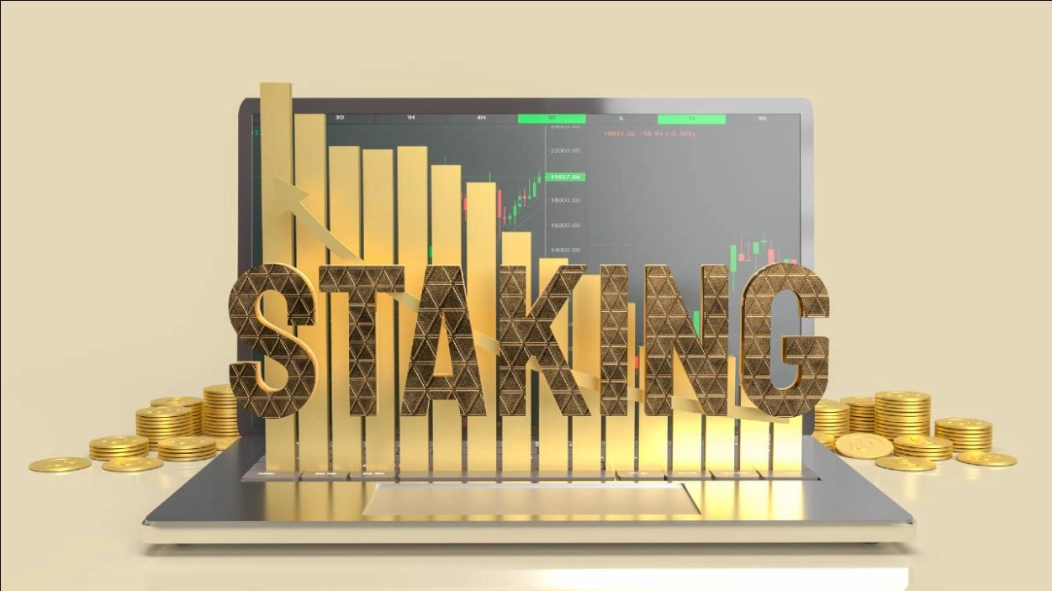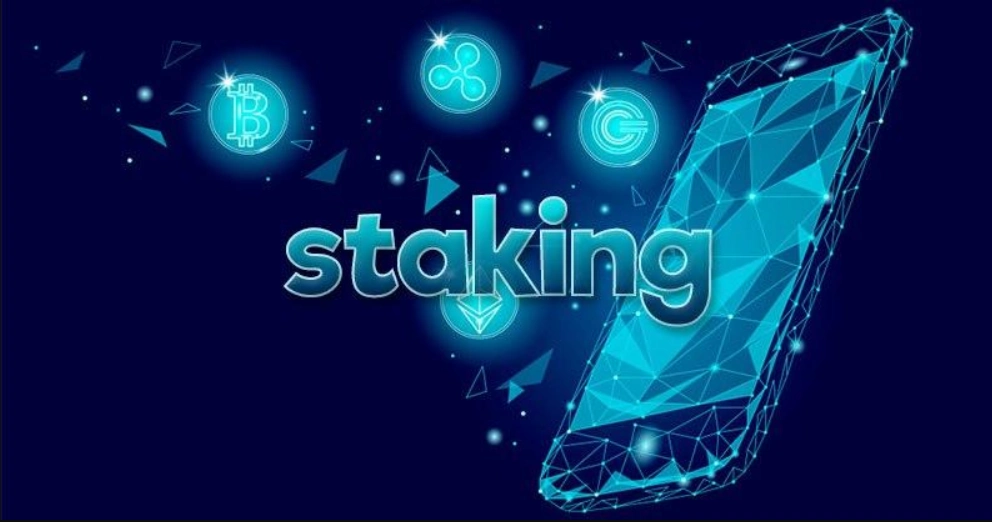What is Staking?
Staking is the process whereby users commit and lock a certain amount of coins for a period of time to contribute to the system and receive corresponding rewards. The locked coins can be in a personal wallet or on project blockchain nodes. The rewards are proportional to the amount of coins staked and the duration of the stake.

In blockchains that use the Proof of Stake (PoS) consensus mechanism, participants stake their coins in the network to validate transactions and generate new blocks. Rewards, including rewards for new blocks and transaction fees, are then distributed to PoS participants as an incentive for their resource contribution.
What is Proof of Stake?
Proof of Stake (PoS) is based on the idea of allowing participants to commit and lock a certain amount of their coins for a specified period. The protocol randomly selects these participants to confirm the next block. The probability of selection is proportional to the amount of coins they have committed to stake – those holding more coins have a higher chance of validating new blocks.

The production of new blocks through this staking mechanism significantly enhances the scalability of the blockchain network compared to the traditional Proof of Work mechanism. Due to this scalability enhancement, the Ethereum network has planned to transition to using the PoS mechanism in its major upgrade, ETH 2.0.
Classifications of Staking
Staking in PoS Consensus Mechanisms
In the Proof of Stake (PoS) consensus mechanism, participants stake their coins to demonstrate transaction processing capability and generate new blocks. In return, they receive rewards corresponding to their contribution, including block rewards and transaction fees. This staking process directly affects the integrity and efficiency of the blockchain network.
Well-known blockchain projects using the PoS mechanism and requiring staking include TomoChain, IOST, OneLedger (OLT), WAX, Tron (TRX), among others.
Although there are some variations like PoSV, DPoS, they all rely on the core concept of staking coins. In this article, the term “PoS” will be used to represent consensus mechanisms based on staking in general.
Staking for Reward

In some cases, users may stake or lock a certain amount of tokens within a project’s ecosystem. However, this staking does not directly participate in transaction verification or any other tasks on the blockchain network.
Instead, staking tokens here serves a purpose similar to “locking” tokens for a certain period. The longer users lock tokens, the more rewards they receive from the project.
A specific example is staking KCS on an exchange (holding KCS). Users receive additional KCS as rewards, with the amount depending on how long they hold KCS. These rewards are taken from the exchange’s profits and are not related to generating new blocks or transaction fees on the blockchain.
Related: What is Cryptocurrency? Ways to Earn Money in Cryptocurrency
How does Staking Work?

Staking is the process of committing and locking a certain amount of coins for a period of time to receive rewards on blockchain networks using the Proof of Stake (PoS) consensus mechanism or its variants. While Proof of Work (PoW) networks use mining to validate new blocks, PoS networks use staking. This allows for the creation of new blocks without relying on mining activities, and PoS validator nodes are selected based on the amount of money they have committed to stake, rather than competing based on computational power. Generally, those who stake more money have a higher chance of validating the next block. Staking requires participants to commit (and hold) a corresponding amount of coins for a certain period. Each PoS network uses its own type of coin for staking.
The block creation process in blockchain networks is optimized through the staking mechanism, which helps to significantly improve the network’s scalability. For this reason, the Ethereum network has decided to transition from PoW (Proof-of-Work) to PoS (Proof-of-Stake) in its Ethereum 2.0 upgrade.
Who Benefits from Staking

For Participants
Staking offers several attractive benefits to participants (stakers):
- Passive income generation and increased coin holdings: This is the most obvious and appealing benefit. Instead of letting coins sit idle on an exchange, stakers can stake them and receive rewards in the form of additional coins. This benefit is particularly suitable for those looking to hold coins long-term. However, it is not suitable for frequent traders.
- Lower costs compared to Proof of Work (PoW): This is evident when comparing the investment costs of mining equipment (ASICs) to the costs for a high-configured computer. Staking typically requires much lower hardware configuration requirements compared to PoW mining, requiring only a simple computer capable of running a node. Although there are requirements for the amount of coins needed to stake, operating costs are significantly lower than PoW, which requires multiple high-configured mining machines.
- Security and predictability: The staking process is conducted safely with data backup capabilities. Before starting, stakers can accurately calculate the expected profits from staking as well as the timing of rewards or withdrawals if they wish to stop midway. This helps stakers manage risks and financial planning easily.
For Projects
Staking in PoS is a method that helps platform blockchain projects achieve decentralization for their networks. Power and processing capability are distributed to participating nodes through staking, rather than being concentrated in a small group. This brings several benefits:
- Utilizing external resources to operate the network through distributed nodes.
- Creating incentives to encourage users to participate in the network by receiving rewards when staking, helping to maintain and expand operations.
- Enhancing network security as its power is distributed among different nodes. This makes it nearly impossible to concentrate enough power to launch an attack.
Risks Associated with Staking

Staking also entails certain risks that participants need to carefully consider:
- Coin lockup: During the staking period, the staked coins will be locked. Stakers will not be able to trade or conduct transactions with this amount. Withdrawing all funds (unstaking) early will result in the loss of accumulated rewards.
- Unstaking time: Even when unstaking, users must wait for a certain period before receiving back the staked amount. This timeframe may not be suitable for other trading opportunities.
- Price decline risk: The biggest risk is a sharp decrease in the price of the coin during the staking period. Although rewards are received in kind (coins), the actual value may be much lower than the initial investment amount.
For example, stake 1,000 coin X (price $0.1/X) with a 30% annual interest rate. When receiving rewards, you will have 1,300 coin X. However, if the price of coin X drops to $0.07, the value of 1,300 coins will be only $91, lower than the initial investment of $100.
Therefore, these risks need to be carefully considered, such as loss of liquidity, early unstaking fees, and especially price fluctuations. Pricing assets and risk management are crucial for effective staking.
Impact of Staking on Coin Prices

When a blockchain project introduces staking, it affects the circulating supply of that coin. Specifically, the staked coins are locked up for a period, preventing them from participating in trading on the market. This leads to a reduction in the circulating supply.
According to the basic principle of supply and demand, when the supply decreases while demand remains constant, it increases the scarcity of the asset, thereby driving the price higher.
Illustrative example with TOMO coin from the TomoChain project: When staking was introduced in December 2018, approximately 64.5% of the circulating TOMO was staked. The price of TOMO increased by 300% during the subsequent period due to the scarcity of supply.
The price increase resulting from staking led many projects to adopt PoS mechanisms to “appease” the community in the early stages. However, when the supply stabilizes, the price will not continue to rise as initially, and staking will only become a form of investment to hold coins and receive rewards.
Key Parameters to Consider in Staking

Inflation Rate
The inflation rate refers to the amount of new coins generated compared to the circulating supply. In PoS staking, rewards for participants come from transaction fees and newly minted coins, causing inflationary impacts. This rate directly affects the circulating supply and the price of the coin.
Lockup Period
The lockup period is the duration during which coins are locked after staking. Users can typically choose this period from the outset, such as 1 month, 3 months, or 1 year. After this period, they can withdraw the staked amount.
Unlocking Period
Most users can unstake before the lockup period ends. However, they will have to wait for a certain period to receive the staked amount. This rule ensures that the unstaking process does not disrupt network operations.
Staking Interest Rate
The staking interest rate is the reward rate received after a certain period. This is an important factor that participants care about. The higher the interest rate, the more coins they receive.
Minimum Amount
The minimum amount is the smallest amount of coins required to start staking. Different projects will have different requirements.
Coin Age
Coin age refers to the time from staking to when the coin begins to earn rewards. Depending on the project, this time can range from a few hours to a few days.
Weight (Age and Coin Amount)
Weight includes age and coin amount. The higher the weight (more coins and older age), the greater the likelihood of receiving rewards. This factor directly affects the profitability of staking.
How to Maximize Profit from Staking?

Based on the factors affecting staking mentioned above, you can adjust them to achieve maximum rewards and profits. This section will guide you through the steps.
Selecting the Appropriate Method
First, determine your needs and the amount of coins you have:
- For Small Amounts (Not Enough to Run a Node/Masternode): The optimal option is to participate in voting or stake in existing nodes to receive rewards. You can stake directly in your wallet or supported exchanges.
- For those looking to hold small amounts long-term, staking will help increase the coin balance over time.
- For Large Amounts: In addition to applying the above method to maintain liquidity, you can also run a node/masternode to directly participate in validation and block creation, receiving higher rewards. However, this method requires higher hardware configuration.
Implementation Steps
Regardless of the method used, you need to follow these steps:
Step 1: Choose a coin with a staking mechanism that suits your needs, budget, and profit expectations by carefully considering factors such as interest rate, inflation rate, and weight.
Step 2: Set up a wallet or prepare your computer configuration ready for staking.
Step 3: Deposit coins into your wallet/computer or exchange to start staking. Ensure that the wallet remains connected to the network 24/7 if using a cold wallet.
Step 4: Wait for the coin to “mature” and start receiving rewards.
Note: To maximize profits, pay particular attention to staking interest rates, inflation rates, prices, and coin weights. These factors determine the final rewards you receive.
Related Terms in Staking
What is Equity Stake?
Equity stake refers to the ownership percentage of shares agreed upon between startups and investors.
The mechanism works as follows: Before raising capital, the startup will price its business valuation. Based on this valuation and the amount of capital that investors commit to invest, they will own a corresponding percentage of shares in the company. When the startup operates profitably, investors will receive profits proportionate to their ownership stake.
What is Binance Staking?

Binance Staking allows users to participate in staking (committing a certain amount of coins) to earn rewards through various products in a user-friendly environment. Examples include Staking ETH 2.0 and Fixed Staking.
Conclusion
Through the article “What is Staking Crypto? Tips to Maximize Profit When Holding Coins“, we have guided you on how to optimize profits when holding a promising coin. So, do you understand what staking is? If not, leave a comment below to have your questions answered!
 OMN
OMN  BTC
BTC  ETH
ETH  USDT
USDT  XRP
XRP  BNB
BNB  SOL
SOL  USDC
USDC  TRX
TRX  DOGE
DOGE 






This is amazing, the staking option
Good content
These is interesting news ,pls , keep on
Staking is vert interesting to me,I liked very much-loved. I thank Azc for amazing crypto news 🙏
Please allow me to write this article down, and translate it to my native language for my people to benefit from your knowledge.